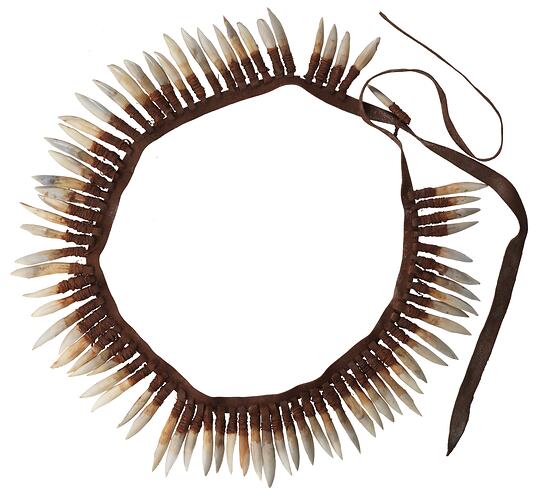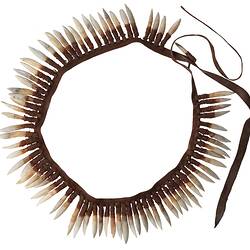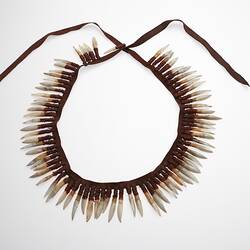Summary
'I'd wanted to make a necklace like this for 15 years, after seeing an historic photograph of a Koorie woman wearing a kangaroo-tooth necklace and a kangaroo-tooth headband. I also went to see two 19th-century kangaroo-tooth necklaces held in the collection at Museum Victoria.'- Maree Clarke, 2010.
To make the meeytmeet, Maree used lean (kangaroo incisors) that she and her family collected from kangaroos found dead along the roads around Mildura and Broken Hill. They were attached to a long strip of kangaroo leather using kangaroo-tail sinew. Creating the necklace was both men's and women's business, with Len and Rocky Tregonning assisting by preparing the kangaroo-skin leather and sinew.
'The sinew had to be moistened by mouth to make it supple and elastic before it could be used to fasten the teeth to the leather strips. As it dries, it shrinks, and the wrapping becomes tight and secure. The leather and sinew were also soaked in ochre.' - Maree Clarke, 2010.
Maree speaks of her commitment to illuminating the traditions of her peoples which have been passed down over countless generations;
'My work is about regenerating cultural practices, making people aware of our culture and that we are really strong in our culture, identity and knowledge. We haven't lost anything; some of these practices have just been lying dormant for a while.' Maree Clarke, 2017.
Maree Clarke is Yorta Yorta/Mutti Mutti/ Boonwurrung/Wemba Wemba and Len Tregonning is Gunnai/Kurnai they collaborated on Meeytmeet or Lean-now. Kangaroo tooth necklace, 2008
Local Name
Meeytmeet or Lean-now
Physical Description
Necklace made of kangaroo teeth bound with sinew and attached to a kangaroo leather band. The leather has been treated with emu oil. Ochre mixed with wattle gum for binding has been applied to the sinew and leather band.
Significance
Maree Clarke is renowned for her multi-disciplinary work which illuminates contemporary stories and histories whilst often utilising techniques from Ancestors passed down over countless generations.
The late 1990s marked the beginning of her exploration of south-east Australian Aboriginal art and its impact on her identity as an Aboriginal artist. Her interest in exploring her own family designs and markings, and the totems connected with her links to the Yorta Yorta, Mutti Mutti, Wemba Wemba and Boon Wurrung language groups were increasingly revealed in her own work.
Between 2004 and 2009 Maree studied and completed a Masters of Arts titled Reflections on Creative Practice, Place & Identity, RMIT University, Melbourne. This research continues to be significant in providing information to Melbourne Museum about the material culture of her Ancestors.
The capacity for art to enable people to reconnect with their cultural heritage and to assist in their recovery remains central to Maree's philosophy concerning the power of art to heal and inspire people to positively identify with their Aboriginality;
'We have to learn all of that cultural knowledge ourselves through research of the colonial record, through talking to Elders and then to actually physically make those objects and items. So our job as artists is to pass that on to our family and communities and anybody who wants to learn really. Even learning from making the possum skin cloaks, to the kopis, or the kangaroo tooth necklace, there is a real men's and women's business involved, so you're actually making and you learn and understand as you go along.' Maree Clarke 2012
More Information
-
Object/Medium
Ornament, neck
-
Maker
-
Cultural Groups
-
Locality
-
Date Produced
-
Exhibition Collection Management
350 mm (Length), 350 mm (Width)
Measurement taken with object laying flat in a circular shape (as in image).
-
Classification
-
Date Made
-
Maker
-
Clan/Language Group
-
Place Made
-
Indigenous Region
-
Keywords
-
Type of item
-
Discipline
-
Category
-
Collecting Areas


